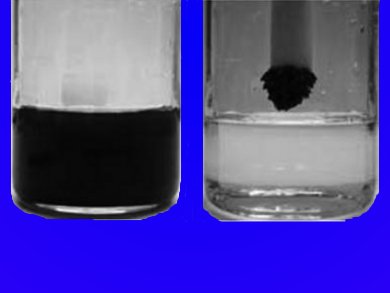As precious metals become rarer and more expensive, the search for alternative catalysts for coupling reactions intensifies. Now, an efficient carbon-carbon bond formation via the Sonogashira–Hagihara reaction has been described by Habib Firouzabadi and co-workers, Shiraz University, Iran. They employ paramagnetic magnetite (Fe3O4) nanoparticles under heterogeneous ligand-free conditions by using ethylene glycol as a solvent and K2CO3 as a base.
The authors demonstrated that the Fe3O4 nanoparticles were responsible for the catalysis, ruling out contamination with trace amounts of Pd, Ni, Cu or Co. The reactions between aryl iodides or activated heteroaryl bromides and alkynes proceeded in the air without any precautionary measures. Separation of the heterogeneous catalyst from the reaction mixture was achieved by applying an external magnetic field (see above). High yields and the ease of separation makes this of potential interest for large-scale operations and industrial purposes.
Image: Complete accumulation and separation of the catalyst particles from the reaction mixture by the magnetic bar. (c) Wiley-VCH
- Magnetite (Fe3O4) Nanoparticles-Catalyzed Sonogashira–Hagihara Reactions in Ethylene Glycol under Ligand-Free Conditions
H. Firouzabadi, N. Iranpoor, M. Gholinejad, J. Hoseini,
Adv. Synth. Catal. 2011.
DOI: 10.1002/adsc.201000390




